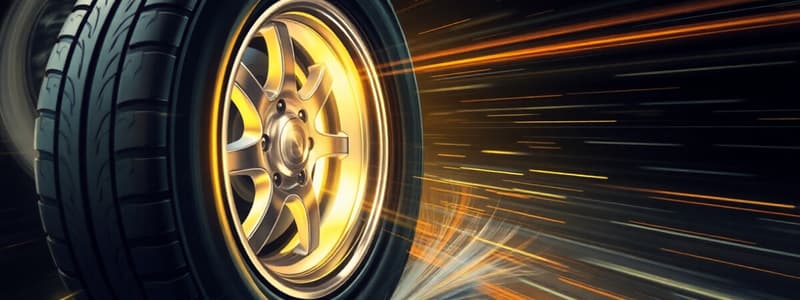Podcast
Questions and Answers
What primarily causes deformation within the tire contact patch in a driven tire?
What primarily causes deformation within the tire contact patch in a driven tire?
- Compressive strain from driving torque. (correct)
- The weight of the vehicle.
- The road surface conditions.
- The tire's high stiffness.
How does 'tire slip' affect the effective rolling radius of a driven tire?
How does 'tire slip' affect the effective rolling radius of a driven tire?
- Increases it beyond the free-rolling radius.
- Maintains it equal to the free-rolling radius.
- Causes it to oscillate around the free-rolling radius.
- Reduces it below the free-rolling radius. (correct)
Under what condition does slip tend to approach 100%?
Under what condition does slip tend to approach 100%?
- When the rotational speed is greater than zero and the velocity is zero. (correct)
- When the rotational speed is greater than zero and the velocity is greater than zero.
- When the rotational speed is zero and the velocity is zero.
- When the rotational speed is zero and the velocity is greater than zero.
What is the significance of 'slip' in the context of longitudinal tire forces?
What is the significance of 'slip' in the context of longitudinal tire forces?
In Julien's Theory, what key simplification is made regarding the normal force distribution within the contact patch?
In Julien's Theory, what key simplification is made regarding the normal force distribution within the contact patch?
According to Julien's Theory, what happens within the contact patch before sliding occurs?
According to Julien's Theory, what happens within the contact patch before sliding occurs?
In the context of tire dynamics, what do C₁ and C₂ represent when discussing tread elements entering the contact patch?
In the context of tire dynamics, what do C₁ and C₂ represent when discussing tread elements entering the contact patch?
What is reduced when tread ribs (longitudinal grooves) are added to tires?
What is reduced when tread ribs (longitudinal grooves) are added to tires?
How is the onset of hydroplaning for grooved tires affected by inflation pressure?
How is the onset of hydroplaning for grooved tires affected by inflation pressure?
Values of peak and sliding friction vary more with what property?
Values of peak and sliding friction vary more with what property?
Flashcards
Driving Torque
Driving Torque
Torque applied to a tire resulting in longitudinal force within the contact patch.
Tire Slip
Tire Slip
Tread length within the contact patch of a driven tire is less than the free-rolling tire.
Effective Tire Radius
Effective Tire Radius
Effective tire radius varies based on factors like load and speed.
Slip Definition (Driven Tire)
Slip Definition (Driven Tire)
Signup and view all the flashcards
Slip Necessity
Slip Necessity
Signup and view all the flashcards
Hydroplaning Effects
Hydroplaning Effects
Signup and view all the flashcards
Hydroplaning Resistance
Hydroplaning Resistance
Signup and view all the flashcards
Hydroplaning Mechanism
Hydroplaning Mechanism
Signup and view all the flashcards
Threshold Speed Due to Hysteresis
Threshold Speed Due to Hysteresis
Signup and view all the flashcards
Skid Ratio (Braked Tire)
Skid Ratio (Braked Tire)
Signup and view all the flashcards
Study Notes
Longitudinal Dynamics of Driven Tire
- Torque applied to a tire results in longitudinal force within the contact patch.
- Low stiffness of tire components leads to deformation within the contact patch.
- Driving torque creates compressive strain in the tread as it enters the contact patch.
- The tread length within the contact patch of a driven tire is less than that of a free-rolling tire.
- The effective rolling radius of a driven tire is less than the rolling radius of a free-rolling tire.
Tire Radii Definitions
- The effective radius of a tire depends on the circumstances.
- Geometric/unloaded radius ((r_u)) can be estimated from the tire size code.
- Free-rolling/loaded radius (r) is affected by tire deformation due to load, which reduces the effective radius.
- Driving/braking radius ((r_e)) experiences strain in the contact patch, altering the effective perimeter and, thus, the effective radius.
- (r_u > r > r_e)
Tire Slip (Driven Tire)
- Slip (i = (1 - \frac{V}{r\omega}) \times 100%), which can also be expressed as (i = (1 - \frac{r_e}{r}) \times 100%).
- As rotational speed increases for a given vehicle speed, slip increases.
- Slip approaches 100% if (\omega > 0) and (V = 0).
- A spinning tire has (\omega > 0) and either (V = 0) or (V \neq f(\omega)), where (f(\omega)) is some function of (\omega).
Effect of Tire Slip on Driving Force
- Slip is required to generate longitudinal force.
Julien's Theory for Driven Tire Longitudinal Dynamics
- The tire tread is treated as a 2-D elastic band.
- Sidewall is ignored.
- Normal force is approximated as uniformly distributed within the contact patch.
- The contact patch is divided into two zones: adhesion and sliding.
- Sliding within the contact patch is not the same as tire slip; a tire can slip even without sliding in the contact patch if (r_e < r).
Simplified Julien's Theory Results: Driven Tire
- Slip ratio i = (1 - \frac{V}{r\omega} \cdot 100%)
- The contact patch is purely in adhesion when (F_x = C_i \cdot i) for (i < i_{crit}), with (i_{crit} = \frac{\mu_p W}{2C_i}) and (C_i = \frac{k_t L_t^2}{2})
- There are mixed adhesion/sliding zones in the contact patch when (F_x = \mu_p W (1 - \frac{\mu_p W}{4 C_i i})) for (i_{crit} < i < i_{peak}).
- The peak tractive force, when exactly 100% of the contact patch is sliding, is (F_x = \mu_p W) at (i = i_{peak}).
- Beyond the peak slip ratio, (F_x \rightarrow \mu_s W) for (i > i_{peak}).
- Simplified Julien's Theory does not predict (i_{peak}).
Tire Skid (Braked Tire)
- Skid definition for a braked tire: (i_s = (1 - \frac{r\omega}{V}) \cdot 100%), which can also be written as (i_s = (1 - \frac{r}{r_e}) \cdot 100%).
- Skid increases as the rotational speed of the tire decreases for a given vehicle speed.
- Skid approaches 100% if (\omega = 0) and (V > 0).
Simplified Julien's Theory Results: Braked Tire
- Skid ratio, (i_s = (1 - \frac{r\omega}{V}) \times 100%), also expressed as (i = \frac{-i_s}{1-i_s}) and (i_s = \frac{-i}{1-i}).
- The contact patch is purely in adhesion when (F_x = C_s \frac{i_s}{1-i_s}) for (i_s < i_{s,crit}), where (i_{s,crit} = \frac{\mu_p W}{2C_s + \mu_p W}), and (\frac{dF_x}{di_s}|_{i_s=0})
- There are mixed adhesion/sliding zones when (F_x = \mu_p W (1 - \frac{\mu_p W (1 - i_s)}{4 C_s i_s})) for (i_{s,crit} < i < i_{s,peak}).
- Peak braking force (when exactly 100% of C.P. is sliding) is (F_x = \mu_p W) at (i = i_{s,peak})
- The braking force beyond the peak skid ratio is (F_x \rightarrow \mu_s W) for (i > i_{s,peak})
- Simplified Julien's Theory does not predict (i_{s,peak}).
Effect of Construction & Surface on Braking
- Braking effort coefficient is defined as Fx/Fz.
Variation of Peak & Sliding Friction
- Typical values for road adhesion coefficients:
- Asphalt & Concrete (Dry): Peak Value ((\mu_p)) = 0.8-0.9, Sliding Value ((\mu_s)) = 0.75
- Asphalt (Wet): Peak Value = 0.5-0.7, Sliding Value = 0.45-0.6
- Concrete (Wet): Peak Value = 0.8, Sliding Value = 0.7
- Gravel: Peak Value = 0.6, Sliding Value = 0.55
- Earth Road (Dry): Peak Value = 0.68, Sliding Value = 0.65
- Earth Road (Wet): Peak Value = 0.55, Sliding Value = 0.4-0.5
- Snow (Hard-packed): Peak Value = 0.2, Sliding Value = 0.15
- Ice: Peak Value = 0.1, Sliding Value = 0.07
- The values of (\mu_p) & (\mu_s) depend more on the surface and rubber composition rather than tire construction style and inflation pressure.
- The peak value is possible to be greater than 1.
Additional Effects: Threshold Speed Due to Hysteresis
- Standing waves can occur in the tread surface at high speeds because the deformation from the contact patch does not relax quickly enough.
- Standing waves result in repeated cycles of compression and relaxation, creating substantial heat through hysteresis.
- Rolling resistance is increased greatly and rapidly because of standing waves through hysteresis.
- Threshold speed is given by (V_{thresh} \approx \sqrt{F_t/\rho_t}), where (F_t) is the tension in the tread and (\rho_t) is the tread density per unit area.
Hydroplaning Mechanism
- Hydroplaning happens when the water film volume flux is greater than the tread evacuation capacity, thus creating a hydrodynamic bearing film between the tire and road.
- Hydroplaning happens when the film has enough volume to support the load on the tire approximated by the inflation pressure and contact patch area.
- Hydrodynamic force is proportional to the contact area and the square of its velocity for slippery or smooth tires.
Additional Effects - Hydroplaning
- Peak and sliding friction coefficients are lowered on wet surfaces.
Hydroplaning Resistance
- Tread ribs (longitudinal grooves) reduce the lateral distance water must be displaced, increasing hydroplaning resistance.
- Tread sipes (lateral grooves) increase lateral flow capacity to improve hydroplaning resistance.
- The onset of hydroplaning for grooved or grooved & siped tires primarily depends on inflation pressure; greater pressure helps displace water from under the contact patch.
- Hydroplaning speed:
- (V_{p(km/h)} \approx 6.34\sqrt{p_i (kPa)})
- (V_{p(mph)} \approx 10.35\sqrt{p_i (psi)})
Studying That Suits You
Use AI to generate personalized quizzes and flashcards to suit your learning preferences.




